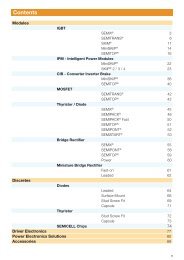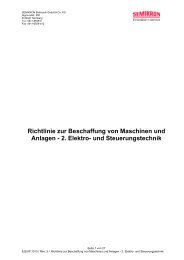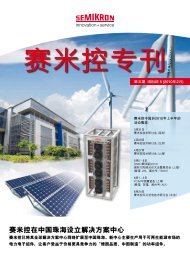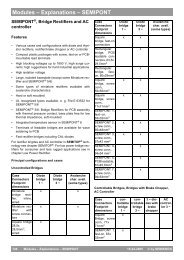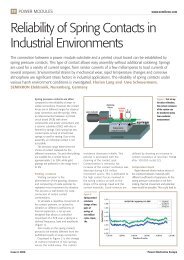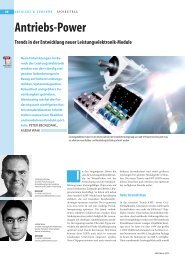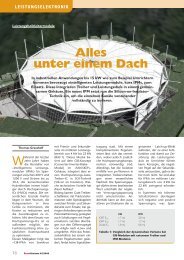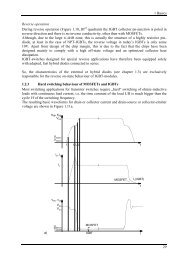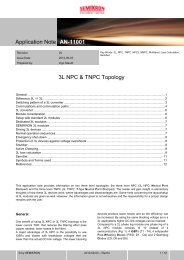Environmental Declaration - Semikron
Environmental Declaration - Semikron
Environmental Declaration - Semikron
Create successful ePaper yourself
Turn your PDF publications into a flip-book with our unique Google optimized e-Paper software.
<strong>Environmental</strong> <strong>Declaration</strong><br />
2007
Foreword<br />
The foreword of our 2004<br />
<strong>Environmental</strong> <strong>Declaration</strong><br />
contained the following statement:<br />
“Energy efficiency and renewable<br />
energies are important sources of<br />
energy. And SEMIKRON<br />
employees draw on these sources<br />
perpetually.” In the past three<br />
years this statement has become<br />
increasingly important and<br />
effective.<br />
Global warming is now upon us.<br />
And the devastating effects that global warming has on the<br />
environment and society is no longer a concern that is restricted to<br />
the scientific world but one that has entered the consciousness of<br />
people across the globe. Ways of meeting rapidly increasing energy<br />
demands and the urgent need to reduce carbon dioxide emissions at<br />
the same time are being sought after fervently.<br />
The solutions can be found in many different areas. 60% of electric<br />
energy is consumed in electric motors. The use of variable speed<br />
drives can bring about savings in the region of double-figure<br />
percentages.<br />
Even though renewable energy has only covered a small proportion<br />
of the total energy demand up till now, the amount of electric energy<br />
generated from renewable sources of energy such as wind power,<br />
solar power or biogas is constantly on the increase.<br />
Whether power generation, power transmission or energy efficiency<br />
systems – the key to achieving improvements will always be power<br />
electronics based on power semiconductors. This is why the family<br />
business SEMIKRON, whose activities have been concentrated in<br />
this area for over 50 years, has not only greater chances in this area,<br />
but also a greater corporate responsibility.<br />
In a rapidly growing enterprise such as ours it’s not just possible to<br />
do ‘more’ but also to make a difference. The continual development<br />
of our organisational structure away from a functional culture toward<br />
a project culture, optimised internal processes and better coordination<br />
between the different processes enable us to meet the<br />
ever increasing demand for power semiconductors without<br />
compromising resource and energy efficiency.<br />
This environmental declaration explains how each and every one of<br />
our employees – our “talents” – have played a part in ensuring that<br />
today we can manufacture power semiconductors at reduced levels<br />
of material consumption, energy consumption and waste production.<br />
You can also read up on the ambitious, yet realistic targets we’ve set<br />
in the areas of environmental protection and occupational health and<br />
safety for the years ahead.<br />
Dr. Thomas Stockmeier<br />
Managing Director<br />
SEMIKRON Elektronik GmbH & Co. KG<br />
We regard our responsibility<br />
towards sustainable action as<br />
being instrumental in maintaining<br />
and improving our environmental,<br />
living and working conditions - a<br />
challenge for the future that we at<br />
SEMIKRON do not take lightly. In<br />
fact, we are committed to taking<br />
forward-thinking action to help<br />
improve these conditions.<br />
One important way of protecting<br />
the environment is to continually<br />
improve the frame conditions in industrial production. We are<br />
currently planning a complete overhaul of our existing infrastructure<br />
at our Nuremberg plant. This will include the construction of new<br />
business premises, including new state-of-the-art water treatment<br />
installations which will allow for the necessary quantities of water to<br />
be produced in an economical and environmentally compatible<br />
process. The new premises will also feature new neutralization<br />
equipment which allows for a reduction in waste levels despite<br />
increased production.<br />
A further important pillar of sustainability is seen in our “talents”<br />
themselves. An important development on this front is the newly built<br />
nursery school on our grounds. During the construction of the<br />
nursery school careful consideration was given to the sustainable<br />
use of available resources. A remarkable achievement in this context<br />
is the transplantation of fully grown trees from the works grounds to<br />
the nursery school garden. The trees were uprooted from our<br />
grounds using specialist machinery and replanted on the new site.<br />
This meant that we were able to save all of the trees that had grown<br />
on our grounds over many years and provide the children of our<br />
talents with a nursery school that is shaded from the sun by a<br />
beautiful garden of trees at the same time. To ensure that the public<br />
sewage system is not polluted with rain water run-off, the nursery<br />
school was fitted with a ‘green’ roof lined with sedum plants.<br />
This measure, like others to come, clearly demonstrates the<br />
responsibility that SEMIKRON feels towards its talents and the<br />
environment we live in, and reflects the duty we have towards<br />
making a better future for each of every one of us.<br />
Jörg Grumann<br />
Environment Officer<br />
2
Contents<br />
Foreword 2<br />
Contents 3<br />
SEMIKRON associated companies (organisational structure) 4<br />
History 5<br />
Applications for SEMIKRON products 6<br />
SEMIKRON products 7<br />
Infrastructure and building management 8<br />
Chip manufacture in SEMICELL division 10<br />
SEMIBOND division: production of modules and systems 11<br />
Driver developments in Electronics division 12<br />
Sales 13<br />
Direct environmental impact 14<br />
Indirect environmental impact / Input - output - results 15<br />
<strong>Environmental</strong> policy 16<br />
<strong>Environmental</strong> management system / Contact persons 17<br />
<strong>Environmental</strong> targets 18<br />
Validation 19<br />
Transplantation of fully grown trees as part of the nursery school project<br />
3
SEMIKRON associated companies<br />
Organisational structure<br />
For over 50 years the headquarters of the <strong>Semikron</strong> Group has been<br />
at the heart of the Nuremberg metropolitan region, with associated<br />
companies spread across every continent on the globe. In 2004, the<br />
two firms SEMIKRON International GmbH and SEMIKRON<br />
Elektronik GmbH & Co. KG were first validated in accordance with<br />
EMAS II at the Nuremberg location. This coincided with DIN EN ISO<br />
14001 certification.<br />
A total of around 1200 “talents” (staff) are currently employed at the<br />
Nuremberg headquarters, which encompasses an area of around<br />
17,500 m 2 in the Sigmundstraße industrial estate in Nuremberg, of<br />
which 8,900 m 2 are built up, 6,500 m 2 sealed and 1,900 m 2 of usable<br />
green space. The Nuremberg headquarters are conveniently located<br />
close to the highway link road Südwesttangente and exclusively<br />
accessible from the public road network.<br />
SEMIKRON International GmbH is the parent company of both<br />
SEMIKRON Elektronik GmbH & Co. KG and the associated<br />
companies in over 50 countries across the globe.<br />
SEMIKRON International GmbH functions as the central sales and<br />
marketing organisation with approx. 30 “talents”. The company is<br />
certified according to NACE code G 51.43.4 “Wholesale trade of<br />
electrical household appliances and radio and TV goods”.<br />
SEMIKRON Elektronik GmbH & Co. KG is responsible for the<br />
development and production of semiconductor chips, power modules<br />
and power electronics systems, as well as for the entire infrastructure<br />
of this site. The company is classified according to NACE categories<br />
DL 31.10.0 “Manufacture of electric motors, generators and<br />
transformers” and DL 32.10.0 “Manufacture of electronic<br />
components”.<br />
SEMIKRON International GmbH<br />
SEMIKRON Elektronik GmbH & Co. KG<br />
Other associated companies<br />
SEMICELL<br />
Modules<br />
Elektronics<br />
QUA<br />
SEMIBOND<br />
Systems<br />
Building Management<br />
4
History<br />
SEMIKRON was founded in 1951 by Dr. Friedrich Josef Martin as a specialist enterprise<br />
for power electronic systems. Today, SEMIKRON is the sole group-independent European<br />
enterprise for power semiconductors operating on the global stage. For many years,<br />
environmental protection has been an important part of SEMIKRON’s activities.<br />
1951 Foundation of SEMIKRON<br />
1969 Construction of four production halls and relocation to new premises in<br />
Sigmundstraße, Nuremberg.<br />
1974 Construction of neutralization system for industrial waste water<br />
1976 Construction of administrative building<br />
1980 Installation of first air washer used to treat waste air with acid content<br />
1980 Switchover from oil to gas heating systems throughout company premises<br />
1984 Construction of first clean room incl. heat recovery in air conditioning equipment<br />
1989 Introduction of patented cardboard packaging SEMIBOX<br />
1990 Start of ground treatment owing to discontinued use of trichlorethane<br />
1998 Construction of new five-storey production building<br />
1998 Since construction work on production building began, cables with PVC content<br />
have no longer been used for electrical installations, even in renovation work on<br />
existing buildings<br />
2000 Successive installation of air conditioning systems with heat recovery in the<br />
production halls<br />
2002 All windows in the administrative building replaced by modern insulated windows<br />
2002 Construction of a new compressed air supply system using stainless steel piping<br />
2003 Construction of a new central gas supply system<br />
2004 Commissioning of two block-type thermal power stations<br />
2005 Extensive and voluntary switchover to lead-free solders → RoHS-compliant<br />
products<br />
2005 Measures for the reduction of water and chemicals consumption in chip<br />
manufacture<br />
5
Applications for SEMIKRON products<br />
A wealth of experience, expertise and know-how accumulated over<br />
many years allows us to offer our customers a wide range of<br />
products and services in the area of power electronics. We supply<br />
the components that make modern electric systems and installations<br />
economical yet powerful.<br />
Our customers can choose from a broad selection of products based<br />
on latest-generation semiconductor chips. We offer both modular<br />
packaging solutions and customer-specific solutions backed by a<br />
comprehensive support service. One of the main areas of application<br />
for SEMIKRON products is variable-speed drives, where our<br />
products help achieve energy savings thanks to the efficient use of<br />
electric energy.<br />
Our products are used in a broad variety of electrical systems and<br />
installations ranging from 1W to 10MW. These include industrial<br />
automation systems such as robots and welding machinery. Our<br />
products can also be found in variable-speed drives in industrial<br />
equipment ranging from “white goods” to elevators.<br />
The area of renewable energy is a further important market for us:<br />
our power inverters are used in various different applications, from<br />
decentralised photovoltaic systems to wind power plants in the<br />
megawatt power range.<br />
Owing to the natural variations in the energy carriers used in<br />
photovoltaic systems and wind power plants, high-quality systems<br />
are needed to adapt the output current with regard to the frequency<br />
and voltage fed into the grid.<br />
All of our products constitute a direct path towards the ecological and<br />
economical use of the all-important resource energy. The many<br />
different applications that our products are used in require a<br />
maximum of know-how. At the same time, our product range must<br />
have the flexibility required for us to be able to meet the different<br />
requirements that occur.<br />
In the transport sector we offer both individual components and<br />
system solutions for use in electric-powered vehicles, fork lift trucks,<br />
trolleybuses, trains and tractors.<br />
6
SEMIKRON Products<br />
SEMIKRON is an innovative manufacturer of power semiconductor chips,<br />
power electronic systems and power semiconductor modules. As<br />
testimony to this, here are some of the highlights of the SEMIKRON<br />
product history:<br />
1959 Development of the first avalanche diode to limit high voltages<br />
1961 HSK- High voltage rectifiers<br />
1963 CSK- Ceramic bridges<br />
SEMIPACK 1<br />
1966 The first 1-amp plastic diode in the world for direct use in PCBs<br />
1974 Development of SEMIPACK ® , a new industrial standard in<br />
module technology to replace single, metal-encapsulated<br />
elements<br />
1980 SEMITRANS ® power semiconductors with bipolar, MOS and<br />
IGBT transistors<br />
1990 Development of CAL diode, the freewheeling diode adapted to<br />
suit the new IGBT generation<br />
1992 SKiiP ® : Integrated power modules in pressure contact<br />
technology<br />
1996 MiniSKiiP ® : Integrated power modules with spring contact<br />
technology<br />
1999 SKiM ® : 6-pack IGBT modules with control electronics<br />
SEMiX 3 IGBT modules with SKYPER driver<br />
2003 Development of the second generation MiniSKiiP ®<br />
2003 SEMiX ® : A new IGBT module family<br />
2004 SKYPER ® : A new family of driver modules (driver electronics),<br />
not only for SEMiX IGBT modules<br />
2005 SEMiX ® family expanded to include diode / thyristor modules:<br />
2005 MiniSKiiP ® 2nd generation → more power with no change in<br />
size<br />
2006 SEMIPACK ® 6: Modules further developed to achieve more<br />
power in new module casing<br />
2007 SEMISTART: A new, more compact softstarter for electric motors<br />
SEMISTART<br />
7
Building management<br />
Media supply – air conditioning technology<br />
One of the most important divisions at the Nuremberg location is the<br />
Building Management division. This division is responsible for the<br />
entire infrastructure at the Nuremberg site, which means that this<br />
division is responsible for ensuring that all of the necessary systems<br />
and installations are in perfect working order at all times.<br />
In relation to chip manufacture, this amounts to providing different<br />
qualities of water and treating the water used in chip manufacture so<br />
that it can be fed into the public drainage system. For this purpose,<br />
SEMIKRON uses a water treatment installation with a reverse<br />
osmosis (RO) unit, two desalination (DS) units and three mixed-bed<br />
(MB) units. At SEMIKRON water used in chip manufacture is re-used<br />
within a cycle, wherever possible. In this way the fresh water<br />
consumption - and consequently the amount of waste water<br />
produced - is kept to a minimum.<br />
Stadtwasser<br />
200kOhm<br />
Kreislauf<br />
Kreislauf<br />
VE Anlage<br />
Zwischenspeicher<br />
VE Anlage<br />
RO Anlage<br />
MB Anlage<br />
Fertigung<br />
Klimatechnik<br />
100kOhm<br />
2MOhm<br />
Neutralisation<br />
Kanalisation<br />
Simplified diagram of the water treatment process showing the different water<br />
qualities obtained. Please note that high resistance values represent water with a<br />
very high level of purity and low ion content.<br />
RO unit: water treatment based on reverse osmosis<br />
VE and MB units: water treatment using ion exchange resins<br />
8
Building management<br />
Media supply – air conditioning technology<br />
Over the past few years, the Building<br />
Management division has taken a number of<br />
minor and major measures to reduce<br />
environmental pollution caused by SEMIKRON.<br />
This includes replacing old light fittings by<br />
lighting systems with control gears that are<br />
automatically adjusted to the given ambient<br />
lighting conditions and making constant<br />
improvements to heat recovery from the air<br />
conditioning technology and from heatgenerating<br />
systems.<br />
For example, the air conditioning system in our<br />
production building is equipped with a waste air<br />
heat recovery system. The air supply is also<br />
preheated using surplus heat from machine<br />
cooling system, and cold air is fed in to machine<br />
cooling system. The warm water in the canteen<br />
and the production halls is heated using the<br />
surplus heat from the compressed air tank.<br />
In order to keep the energy used for air<br />
conditioning technology to a minimum, the<br />
proportion of circulating air is increased to up to<br />
80%, depending on the given temperature and<br />
the air humidity of the external air.<br />
Thanks to measures such as these, we were<br />
able to keep the consumption of primary energy<br />
- mainly electricity and gas - virtually constant.<br />
In the same period of time, the number of staff<br />
(“talents”) increased by over 40% and<br />
production by over 100%.<br />
The main goal of Building Management in<br />
cooperation with the management is the<br />
construction of new operations and service<br />
building. This will include a complete overhaul of<br />
the water conditioning and neutralization<br />
systems.<br />
In addition, to achieve energy savings of over<br />
20% the air wash systems will be replaced by<br />
new systems. The storage tank for combustible<br />
fluids will also be renewed.<br />
12<br />
11<br />
10<br />
9<br />
8<br />
7<br />
6<br />
2002 2003 2004 2005 2006<br />
ph value of water fed through the neutralization system into the public drainage system, including the<br />
given limits<br />
80<br />
70<br />
60<br />
50<br />
40<br />
30<br />
20<br />
10<br />
0<br />
2002 2003 2004 2005 2006<br />
Average quantity of waste water fed into the drainage system weekly (in m³). Thanks to water<br />
consumption efficiency measures, the average quantity of waste water fed into the drainage system<br />
has increased by just 50%, despite a 100% increase in wafer production since the beginning of 2002.<br />
In view of further production increases, the permissible volume of waste water to be fed into the<br />
drainage system was increased to 80m³.<br />
700<br />
600<br />
500<br />
400<br />
300<br />
200<br />
100<br />
0<br />
Electricity<br />
Gas<br />
2002 2003 2004 2005 2006<br />
Average monthly gas and electricity consumption, converted to tonnes of CO2 equivalents.<br />
9
Chip manufacture in SEMICELL division<br />
The basis for our power modules and systems is<br />
created in our chip manufacture division<br />
SEMICELL, where we produce latest-generation<br />
semiconductor chips (cf. 2004 <strong>Environmental</strong><br />
<strong>Declaration</strong>). This division is responsible for the<br />
entire process chain from the unprocessed wafer<br />
stage to the finished chips.<br />
The inside of a vaporization unit developed in-house. This unit is used to apply a multi-layered metal<br />
coating to the semiconductor chips to prepare them for soldering or bonding.<br />
5<br />
4<br />
3<br />
2<br />
1<br />
0<br />
2002 2003 2004 2005 2006<br />
Etching agent consumption (ml) per square centimetre of processed wafer. The 2006 target of<br />
4.0ml / cm² was already met in 2005. The current consumption is approx. 40% lower than the target<br />
line. The new target for the years ahead is 2.0ml / cm².<br />
4<br />
3<br />
2<br />
1<br />
0<br />
2002 2003 2004 2005 2006<br />
Solvent consumption (ml) per square centimetre of processed wafer. The 2006 target of 2.4ml / cm²<br />
was already met in 2004. The current consumption is more than 50% lower than the target line. The<br />
new target for the years ahead is 0.8ml/ cm².<br />
Due to the extensive wet chemical processes<br />
used, the SEMICELL division produces the<br />
greatest environmental impacts. The processes in<br />
this division have therefore been continually and<br />
successfully optimised over the past few years, in<br />
particular with regard to media consumption.<br />
Automation has also been introduced gradually.<br />
Over the past few years, such measures have led<br />
to a substantial decrease in the specific water and<br />
acid consumption per wafer, as well as the<br />
consumption of other media.<br />
We may have succeeded in reducing media<br />
consumption despite increased production – but<br />
we will not stop here. In fact, we are striving to<br />
further decrease media consumption in the future.<br />
To do so, the degree of automation will be<br />
increased. The new automated production<br />
equipment will help optimise the use and<br />
consumption of media by comparing the lifetimes<br />
of individual media with the number of wafers<br />
processed. Here, the maximum possible lifetime is<br />
always determined. This measure is one way of<br />
avoiding unnecessary change of media. It’s one<br />
thing to help the environment by using<br />
environmentally compatible processes on used<br />
media. A more efficient way of protecting the<br />
environment, however, is not to consume media in<br />
the first place.<br />
Thanks to the equipment and installations we use,<br />
some of which were designed especially for<br />
SEMIKRON, we can fully protect our staff from the<br />
dangers and risks posed by vapour with acid or<br />
solvent content - and make yet another important<br />
contribution towards the protection of the<br />
environment at the same time.<br />
Further savings are to be achieved with the use of<br />
reverse osmosis (RO) water instead of<br />
desalination (DS) water on the wafer saws. Here,<br />
savings in the range of at least 5000 litres per year<br />
are expected for the acids and lyes used in the<br />
regeneration of the ion exchange resins. This will<br />
also bring about a reduction in the consumption of<br />
water in the subsequent rinsing process.<br />
The chips produced in the SEMICELL division go<br />
directly to external customers or are used in the inhouse<br />
production of power modules in the<br />
SEMIBOND division.<br />
10
SEMIBOND division: production of modules and systems<br />
In the SEMIBOND division the chips that are produced in-house or<br />
procured externally are assembled on substrates. This process<br />
involves a number of individual steps, starting with the application of<br />
solder and followed by chip assembly and soldering in high-tech<br />
soldering systems. Finally, wire bonds are used to create the<br />
electrical connections between the chips and the substrate.<br />
Compared with chip manufacture, the SEMIBOND division has very<br />
little environmental impact, although this does not mean that there is<br />
no room for improvement. For example, a new closed-system<br />
cleaning unit which cleans the printing screens used for solder<br />
application using an aqueous cleansing agent was installed.<br />
Further room for improvement can be found in packaging. Here, we<br />
will be working in cooperation with our supplier to reduce the amount<br />
of packaging used for the base substrates by 25%. The development<br />
of solder paste constitutes a further area where a significant<br />
improvement could be made. On this front, thanks to critical process<br />
improvements, we have succeeded in finding a way of having the<br />
solder paste mixed directly by the customer and delivered for use in<br />
the intended system as a finished product – with no compromise to<br />
quality whatsoever.<br />
The re-structured Modules division and the Systems division cultivate<br />
a direct customer/supplier relationship with the SEMIBOND division,<br />
where they receive the assembled substrates for their packaging<br />
solutions. These divisions produce a wide variety of power modules<br />
and systems, for instance SEMiX, MiniSKiiP, SKiiP and SEMISTART.<br />
All of these products have the same goal, i.e. to ensure that the<br />
customer’s energy input is utilised as economically and as effectively<br />
as possible.<br />
The Modules and Systems divisions also have very little<br />
environmental impact. One important environmental factor is the<br />
procurement of materials and external parts. Here, we are working<br />
with our suppliers to increase the proportion of reusable packaging<br />
used in order to minimize the use of natural resources for transport<br />
packaging. In a similar vein, we are striving to increase the proportion<br />
of reusable packaging used for delivery to our customers.<br />
An important goal is the changeover in electroplating with regard to<br />
externally purchased copper base plates and connecting elements.<br />
Here, we wish to change over from silver to nickel plating. The aim is<br />
to have our suppliers move away from using mercury in their<br />
electroplating processes.<br />
A further goal is to reduce the amount of encapsulation materials<br />
used for electrical isolation in power modules by at least 20%. To do<br />
so, the amount of encapsulation material used is checked and<br />
reduced as far as possible. One particularly effective possibility in this<br />
context is to use a coating process developed at SEMIKRON more<br />
often.<br />
A further target in the Modules division is a 50% reduction in the use<br />
of solvents to clean different modules with no base plate.<br />
In the Systems, the glycol used on the test chambers is to be<br />
replaced entirely by an environmentally compatible product. Further,<br />
inserted encapsulation material is no longer to be used in driver<br />
circuitry. This amounts to at least 50 grams less material per driver<br />
circuit.<br />
Spring contacts, adapted to meet the given requirements, are<br />
used for electrical connection in modern power modules from<br />
SEMIKRON.<br />
Our compact power modules are ideal for use in decentralised power supply<br />
systems such as photovoltaic systems owing to their high degree of reliability.<br />
11
Driver developments in Electronics division<br />
The “Electronics” division has a special role to play. This is where<br />
triggering thyristors for power modules and systems are developed.<br />
However, these are not manufactured in-house but by external<br />
suppliers. Our suppliers are our partners and they share our<br />
philosophy towards environmental protection. They only use parts<br />
and components that have been approved by us and that meet our<br />
demands, including our environmental requirements. Here, too,<br />
together with our regional suppliers, we will continue to promote the<br />
changeover to reusable packaging.<br />
Triggering thyristors, also known as driver circuits, are supplied to the<br />
“Systems” division, to our foreign subsidiaries and also to external<br />
customers.<br />
The power modules and systems are controlled by driver circuitry.<br />
Only an intelligent triggering thyristor that is adapted to the power<br />
module can use the potential for energy conservation significantly<br />
and effectively for the benefit of the environment.<br />
importance to reliability. Drivers sold over the counter have already<br />
been switched over and are now only available in RoHS-compliant<br />
designs.<br />
For component assembly with discrete parts, we plan to only use<br />
long-life electrolyte capacitors with a guaranteed life of 16 years<br />
instead of the usual 8 years. Although these capacitors are<br />
correspondingly more expensive to purchase, their increased life<br />
guarantees both greater reliability and a lower consumption of<br />
resources.<br />
Consumption of resources and reliability are also main areas of focus<br />
for a new generation of driver circuitry. Here we are planning to use a<br />
digital interface with a lower number of individual components that<br />
will provide higher intelligence, thus continuing to increase the<br />
efficiency with which energy produced is converted into useable<br />
energy.<br />
All of our driver circuitry is now available in designs which are<br />
compliant with RoHS. A changeover within systems is being carried<br />
out in close cooperation with our customers, who attach the utmost<br />
A modular driver from the SKYPER family used in combination with a SEMiX power module<br />
12
Sales<br />
As a business segment of SEMIKRON International GmbH, the<br />
Sales Division is responsible for marketing SEMIKRON products<br />
worldwide. It cultivates contacts with existing customers and<br />
presents our products to potential customers. It also develops<br />
new business segments in order to further promote the use of<br />
energy-saving technology.<br />
The key responsibility of the Sales Division, the interface<br />
between manufacturing and the customers, also requires us to<br />
observe and react to new national and international statutory<br />
provisions.<br />
Currently, the focus is on two provisions. On the one hand, the<br />
European Union regulation “REACh“* and, on the other hand,<br />
the introduction of a Chinese regulation on toxic chemicals<br />
“China RoHS”.<br />
Within the framework of the REACh standard, we will assess the<br />
sources of supply of the substances we use. In so doing, we will<br />
pay particular attention to suppliers outside Europe and to the<br />
question of whether their substances are registered.<br />
Subsequently, we have to decide whether it is possible to<br />
replace non-registered substances or whether it is necessary to<br />
start using SEMIKRON’s registration procedure.<br />
Within the framework of the requirements of the planned “China<br />
RoHS”, we will assess this regulation and then draw up related<br />
measures for our production and products.<br />
Power semiconductors guarantee smooth acceleration and<br />
deceleration in high-speed elevators.<br />
* 2006/1907/EG: REACh -<br />
Registration, Evaluation and<br />
Authorisation of Chemicals<br />
Modern power modules are compact, lightweight and very reliable, making them predestined for automotive<br />
applications.<br />
13
Direct environmental impact<br />
At SEMIKRON Elektronik GmbH & Co. KG in Nuremberg, the areas<br />
of energy consumption, water consumption, waste air, treatment of<br />
environmentally relevant substances, waste water and waste<br />
produce significant environmental impacts. At SEMIKRON<br />
International GmbH, on the other hand, the only area with<br />
considerable environmental impacts is the area of waste.<br />
These significant environmental impacts are regularly assessed by<br />
our internal experts in conjunction with an external appraiser. At<br />
SEMIKRON no significant environmental impact is produced by noise<br />
pollution.<br />
With the exception of the two block-type thermal power plants,<br />
SEMIKRON does not operate any equipment or machinery which is<br />
subject to approval in accordance with the German Emission<br />
Protection Law.<br />
Energy consumption<br />
The forms of energy used are electrical energy, municipal gas,<br />
vacuum and compressed air. All of the electrical energy required is<br />
taken mainly from the public grid. A back-up system in the form of<br />
two block-type thermal power plants exists. Electrical or fossil fuel<br />
energy that is converted into thermal energy, for example from the<br />
diffusion processes or the block-type thermal power plants, is used<br />
by the Building Management division for air conditioning systems for<br />
secondary purposes. Thermal energy generated from municipal gas<br />
is used for heating purposes as well as for primary energy purposes<br />
such as cooling in refrigerating equipment. The cooling water used is<br />
pumped in closed circuits only. The compressed air generation<br />
system and the entire compressed air system are new, the operating<br />
pressure has been reduced to 6 bar, and the supply network<br />
constructed of plastic (PE) and stainless steel.<br />
Water consumption<br />
Water is used as both sanitary water and, following treatment,<br />
deionised water in semiconductor production.<br />
In order to reduce fresh water consumption, process water from<br />
semiconductor production goes through a water circulation system,<br />
provided this is possible. Water substations in production are fitted<br />
with distribution guides that separate the water on the basis of a<br />
given control parameter. Depending on the acid concentration, the<br />
waste water is then transferred either to the neutralization system<br />
(high acid concentration) or the water treatment unit (low acid<br />
concentration).<br />
Waste air<br />
Waste air containing acid undergoes purification in the air washer. In<br />
this process, legal limits are always observed. Waste air containing<br />
solvents is largely avoided thanks to continual improvements and the<br />
use of new processes. The resultant waste air is extracted from the<br />
workplace using extraction systems. The waste air does not contain<br />
dust or other impurities.<br />
Waste water<br />
Production processes and regeneration processes in the water<br />
treatment units mainly produce waste water containing acids, but<br />
also with alkaline content, albeit to a far lesser degree. One single<br />
production process produces batch-like nickel ions in the waste<br />
water. All this waste water is transferred to a neutralization system<br />
with nickel precipitation. In accordance with the provisions of the<br />
relevant statute, the waste water fed into the municipal drains is<br />
slightly alkaline and has a nickel concentration lower than 1mg/m³.<br />
The waste water quality is constantly monitored both internally and<br />
by the municipal authorities at selected intervals.<br />
Waste<br />
Waste management is the central responsibility of the Chemical<br />
Supply and Disposal division and is monitored by the Occupational<br />
Health and Safety and <strong>Environmental</strong> Protection division. All waste<br />
that is produced is separated systematically and then either re-used<br />
or disposed of accordingly. All waste management monitoring<br />
activities are documented in a database for environmentally relevant<br />
substances.<br />
Dangerous waste<br />
Dangerous waste originating from our previous use of trichlorethane<br />
as a cleansing agent is still located on our premises. The type and<br />
extent of pollution arising from this waste is known; the site is treated<br />
as part of an ongoing active ground treatment programme carried out<br />
in close cooperation with the relevant authorities.<br />
Handling environmentally relevant substances<br />
All environmentally relevant substances and facilities/equipment in<br />
which these substances are used are documented in a databasesupported<br />
register which is updated regularly. The procedures<br />
derived from the safety datasheets are also set down here. Any new<br />
substance to be purchased or used is checked for relevance to<br />
environmental protection and occupational health and safety and not<br />
released until these checks render positive results. In this way, the<br />
environmental compatibility of any such substance is guaranteed. On<br />
the basis of an internal list of prohibited substances, no carcinogenic<br />
substances or substances that may cause genetic changes or<br />
mutations are permitted for use.<br />
Packing drums with water pollutants are stored, transported, used in<br />
production and set aside for disposal in suitable collecting basins. To<br />
ensure that our employees are not exposed to hazardous<br />
substances, limiting values are measured at regular intervals and<br />
biological monitoring checks carried out.<br />
14
Indirect environmental impact<br />
Input - output - results<br />
Over the past few years a central European warehouse for all<br />
SEMIKRON products has been built up in the direct vicinity of the<br />
Nuremberg headquarters. This helps simplify storage and optimize<br />
product transport.<br />
Power semiconductor modules and entire power semiconductor<br />
systems based on these modules are transported all over the world<br />
by forwarding agents. The standard packaging unit for modules is<br />
less than 50kg for a volume of 0.5m³, while that of semiconductor<br />
systems is approximately 200kg for 2m³. Sales are carried out<br />
predominantly via distributors, but also with direct customers or via<br />
the different SEMIKRON offices throughout the world.<br />
We strive to meet all of our customer wishes and requirements<br />
regardless of the nature. Here, one of our main aims is to develop<br />
environmentally friendly products using environmentally compatible<br />
materials. In relation to this, all power semiconductor modules and<br />
driver circuits that are not set to be discontinued at SEMIKRON<br />
comply with the provisions of the EU Directive 2002/96/EC (RoHS*).<br />
This includes the changeover to lead-free soldered connections and<br />
the non-use of certain flame-retardants.<br />
The effectiveness of the measures undertaken is monitored regularly<br />
by an independent institute. The results of these checks are made<br />
available to our customers on request.<br />
The materials used to pack SEMIKRON products are<br />
environmentally compatible and recyclable. Packaging is optimized<br />
to allow for a minimum of material to be used and to provide the<br />
products with optimum protection during transportation.<br />
Given the afore-mentioned power savings due to the use of power<br />
electronics components and systems, SEMIKRON plays both a direct<br />
and indirect role in protecting the environment.<br />
At SEMIKRON procurement is dealt with in set procedures in which<br />
environmentally relevant aspects are taken into consideration.<br />
Procurement is the sole responsibility of the Purchasing division. The<br />
only exception is the procurement, installation and provision of<br />
hardware and software, which is carried out by the IT division.<br />
* Restriction of the use of certain hazardous substances in electrical<br />
and electronic equipment – implemented in Germany by the Electrical<br />
and Electronic Equipment Act (ElektroG) concerning the marketing,<br />
take-back, and environmentally sound disposal of electrical and<br />
electronic equipment.<br />
Input<br />
Output<br />
Electricity<br />
Gas<br />
Water<br />
Treated waste water<br />
12,100 MWh<br />
7,500 MWh<br />
78,900 m 3<br />
12,000 m 3<br />
Treatable waste<br />
Non-hazardous<br />
302 t (100%)<br />
247 t<br />
Hazardous<br />
55 t<br />
Disposable waste<br />
191 t (100%)<br />
Non-hazardous<br />
99 t<br />
Hazardous<br />
92 t<br />
Production output (relative) 100,0 %<br />
2002 2003 2004 2005 2006<br />
12,000 MWh<br />
7,400 MWh<br />
83,400 m 3<br />
13,100 MWh<br />
7,400 MWh<br />
86,500 m 3<br />
9,500 m 3 11.500 m 3<br />
343 t (113%)<br />
288 t<br />
345 t (114%)<br />
298 t<br />
12,500 MWh<br />
9,300 MWh<br />
13,900 MWh<br />
9,200 MWh<br />
87,100 m 3 109,400 m 3<br />
13,100 m 3 16,800 m 3<br />
413 t (137%)<br />
355 t<br />
471 t (156%)<br />
396 t<br />
55 t<br />
181 t (95%)<br />
47 t<br />
203 t (106%)<br />
58 t<br />
206 t (108%)<br />
75 t<br />
242 t (127%)<br />
93 t<br />
80 t<br />
99 t<br />
92 t<br />
118 t<br />
88 t<br />
150 t<br />
92 t<br />
113,0 % 137,0 % 158,0 % 250,0 %<br />
Despite a 150% increase in production output compared with<br />
the reference year 2002, the consumption of gas, electricity<br />
and water has only increased by between 15% and 40%.<br />
Similarly, the amount of waste produced has gone up<br />
moderately despite the significant increase in production<br />
output.<br />
With the help of external consultation, inspections were carried<br />
out to ascertain whether the amount of waste produced, in<br />
particular hazardous substances, can be further reduced. The<br />
inspections provided no substantial new impetus. Potential for<br />
financial savings was not indicated to the benefit of our reliable<br />
regional partners<br />
15
<strong>Environmental</strong> policy<br />
Occupational health and safety and environmental protection are an<br />
integral part of our management principles and thus determine our<br />
worldwide policy. By following these principles we create a safe and<br />
healthy working environment. Plus, with the economical use of raw<br />
materials and minimization of emissions, we contribute to<br />
conservation of our environment and thus to the continued success<br />
of our company.<br />
Efficient occupational health & safety and environmental<br />
management<br />
Our occupational health & safety and environmental management<br />
system is constantly being improved. We develop forward-thinking<br />
business plans and implement these together with our contracting<br />
parties. We regularly assess both the implementation of standards in<br />
all areas and the success of our management system.<br />
Safe and ergonomically designed workplaces<br />
We firmly believe that all accidents at work and occupational<br />
illnesses can be avoided. Motivated “talents” and senior members of<br />
staff are helping us on our way towards to zero accidents at work.<br />
We give equal priority to protecting our staff and our suppliers.<br />
When designing workplaces and establishing work procedures, we<br />
always take the latest standards and developments into account. We<br />
attach great importance to the ergonomic design of workplaces.<br />
Reliability<br />
We are committed to observing all laws and stipulations regarding<br />
occupational health and safety and environmental protection. We<br />
behave responsibly in accordance with our own regulations, which<br />
often go beyond the legal provisions. Our machines and installations<br />
are planned, bought, operated and maintained so as to rule out<br />
potential hazards, minimise risks and avoid stoppages. We strive to<br />
use state-of-the-art technology at all times and upgrade our<br />
production equipment continually.<br />
Low environmental impact and environmentally compatible<br />
products<br />
With a view to the future, we aim to prevent harmful effects on the<br />
environment in all our activities. We use our raw materials and<br />
energy economically. We make an effort to produce as little waste,<br />
sewage, noise and other emissions as possible. We manufacture<br />
environmentally compatible products, taking into consideration the<br />
entire product life cycle.<br />
Responsible staff<br />
By providing regular information and involving our staff in training<br />
programmes, we are continually striving to improve our employees’<br />
and business partners’ competence and awareness of a sound<br />
working environment and environmental protection in all areas of<br />
business.<br />
Preventive measures<br />
We protect our employees from health risks and hazards and our<br />
environment from damage by taking extensive preventive action. In<br />
the event of accidents, we provide comprehensive and effective<br />
emergency treatment on site for our staff and visitors.<br />
Open dialogue<br />
We are involved in intensive dialogue with the relevant parties from<br />
the area of environmental protection, providing information on our<br />
occupational health & safety and environmental protection measures<br />
and the environmental impact our company has.<br />
16
<strong>Environmental</strong> management system<br />
Contact persons<br />
SEMIKRON upholds an integrated, process-oriented management<br />
system for quality assurance, environmental protection and<br />
occupational health and safety, which serves to ensure that all<br />
internal processes and their interfaces are described in detail,<br />
constantly monitored, evaluated and continually improved. The basic<br />
elements of this system, known as the QUA management system,<br />
are set down in the quality, environmental protection and<br />
occupational health and safety manual.<br />
SEMIKRON’s participation in EMAS II and DIN EN ISO 14001 clearly<br />
demonstrates our achievements in the field of environmental<br />
protection as well as the ongoing improvements in this area. As part<br />
of a suitable environmental evaluation, all of the relevant aspects of<br />
our activities were investigated and their environmental impact<br />
evaluated. This environmental declaration is testimony to the<br />
responsibility we bear towards our employees, our customers and<br />
the general public. Our environmental protection management<br />
system is therefore closely linked with the occupational health and<br />
safety management system in accordance with OHRIS* and our<br />
quality management system in accordance with DIN EN ISO<br />
9001:2000 and VDA 6.1. This interconnection can also be seen in<br />
the distribution of responsibilities and tasks within SEMIKRON.<br />
The responsibility for the QUA management system lies directly with<br />
the management staff. The officers for the QUA management system<br />
are organised as staff units which have the full support of the<br />
management. In the production areas the relevant QUA officers are<br />
responsible for carrying out the relevant tasks within the<br />
management system. Issues pertaining to quality, environmental<br />
protection and occupational health and safety are dealt with at<br />
fortnightly meetings as well as at the QUA committee conference. All<br />
employees are informed of the activities in the field of environmental<br />
protection at least once yearly and are involved in the environmental<br />
management system within the framework of their individual areas of<br />
responsibility. Similarly, the internal suggestion system SEMIDEE<br />
provides an uncomplicated channel for employees to put forward any<br />
ideas they may have.<br />
As part of the emergency management system at SEMIKRON, an<br />
alarm system which is directly linked up to the local fire brigade<br />
service is installed. An internal emergency call system also exists,<br />
allowing the relevant employees to be notified by the 24-hour<br />
gateman outwith normal working hours. Regular drills are also<br />
carried out to assess the emergency action programme and to<br />
determine where improvement is needed.<br />
The management reviews the management system at least once<br />
annually to ensure that the goals are being met and to assess the<br />
effectiveness of the management system. Preventative and<br />
corrective action is decided upon, where called for.<br />
The management system undergoes regular evaluation and an<br />
annual audit to ensure that the system is continually improved and to<br />
assess the effectiveness of individual measures.<br />
*Occupational Health and Risk System<br />
<strong>Environmental</strong> protection and occupational health &<br />
safety management<br />
Integration of quality management,<br />
environmental protection management and<br />
occupational health & safety management (QUA)<br />
Jörg Grumann<br />
Tel.: +49-911-6559-833<br />
Fax: +49-911-6559-77-833<br />
e-mail: joerg.grumann@semikron.com<br />
Dr. Harald Kobolla<br />
Tel.: +49-911-6559-216<br />
Fax: +49-911-6559-77-216<br />
e-mail: harald.kobolla@semikron.com<br />
Kerstin Wibbeke<br />
Tel.: +49-911-6559-151<br />
Fax: +49-911-6559-77-151<br />
e-mail: kerstin.wibbeke@semikron.com<br />
17
<strong>Environmental</strong> targets<br />
2007 2008 2009<br />
SEMIKRON International GmbH<br />
Ramifications and implementation of the REACh regulation for SEMIKRON Sales <br />
Ramifications and implementation of the China RoHS directive<br />
SEMIKRON Elektronik GmbH & Co. KG<br />
Sales<br />
<br />
Install a new neutralization installation<br />
Install a new water treatment system<br />
Management<br />
Management<br />
Renew air wash systems<br />
Building Management<br />
Re-design storage facilities for combustible liquids<br />
Building Management<br />
Replace desalination (DS) water for chip saws<br />
SEMICELL<br />
Re-organise handling processes for hazardous substances<br />
SEMICELL<br />
Procure more installations with reduced consumption<br />
SEMICELL<br />
Change over from silver to nickel plating<br />
Modules<br />
Increase percentage of reusable packaging used by customers<br />
Modules<br />
Reduce the use of solvents in cleaning processes<br />
Modules<br />
Replace glycol in the water cooling system used in the test chambers<br />
Systems<br />
Optimise the consumption of encapsulation material<br />
Systems<br />
Discontinue the use of encapsulation material in driver circuits<br />
Systems<br />
Reduce packaging used by substrate suppliers<br />
SEMIBOND<br />
Purchase solder paste as finished product<br />
SEMIBOND<br />
Introduce new washing processes with water-based cleansing agents<br />
SEMIBOND<br />
Use long-life electrolyte capacitors<br />
Elektronics<br />
Introduce reusable packaging for suppliers<br />
Elektronics<br />
<br />
<br />
<br />
<br />
<br />
<br />
<br />
<br />
<br />
<br />
<br />
<br />
<br />
<br />
<br />
<br />
<br />
<br />
Conclude the changeover to RoHS-compliant drivers Elektronics <br />
18
Validation<br />
Certificates<br />
Publication of next environmental declaration<br />
The next environmental declaration is due for publication in July 2010. An<br />
update containing the most important data shall be published annually.<br />
DIN EN ISO 14001<br />
Validation was carried out parallel to DIN EN ISO 14001:2005<br />
certification.<br />
Umweltpakt Bayern<br />
SEMIKRON International GmbH and SEMIKRON Elektronik GmbH & Co.<br />
KG remain committed to the Umweltpakt Bayern, the environmental<br />
action programme of the Free State of Bavaria.<br />
Authorised <strong>Environmental</strong> Appraiser<br />
Dipl.-Ing. Peter Fischer<br />
Schützenstraße 12<br />
90596 Schwanstetten<br />
Germany<br />
Licence number: DE-V-0060<br />
19
SEMIKRON International GmbH<br />
SEMIKRON Elektronik GmbH & Co. KG<br />
Sigmundstraße 200<br />
90431 Nürnberg<br />
Telefon: ++49-911-6559-0<br />
Telefax: ++49-911-6559-262<br />
www.semikron.com<br />
UM-HKo-V8-102007



